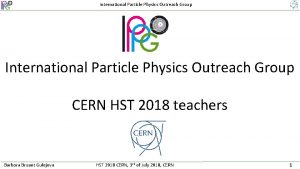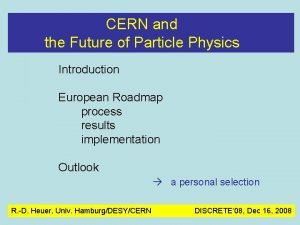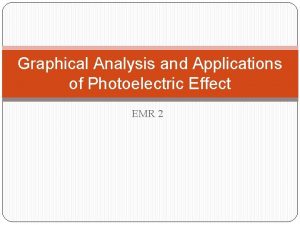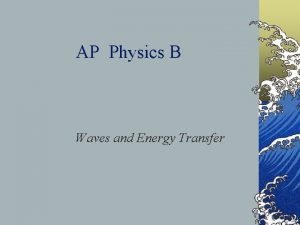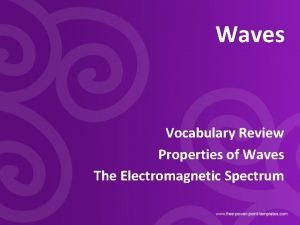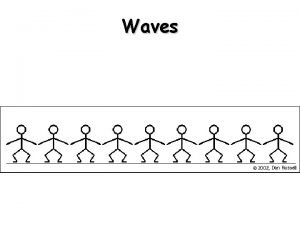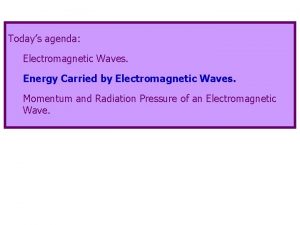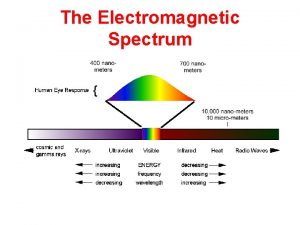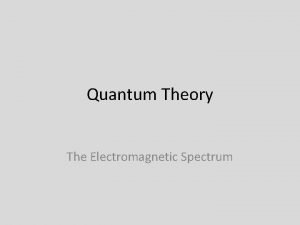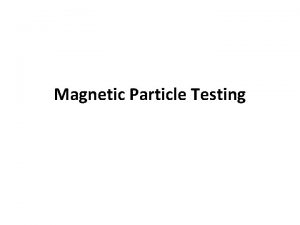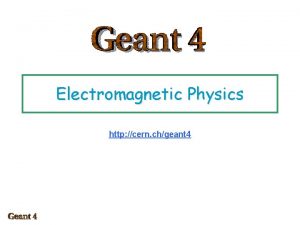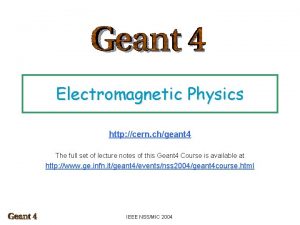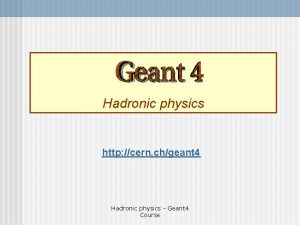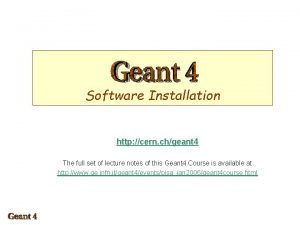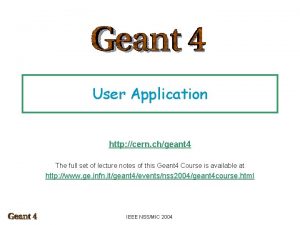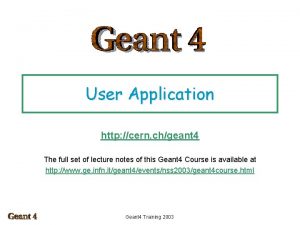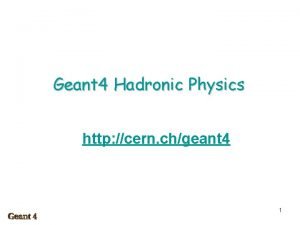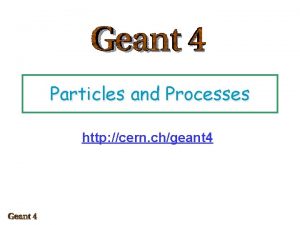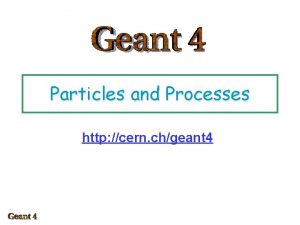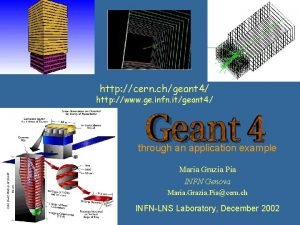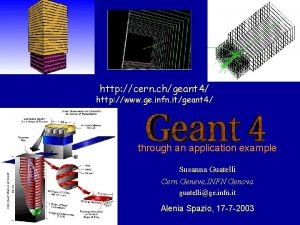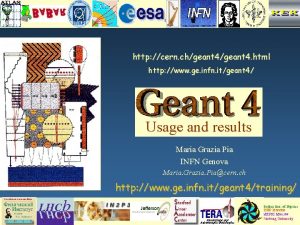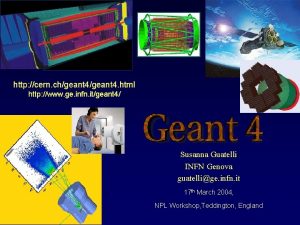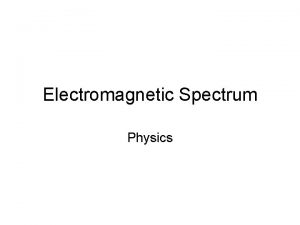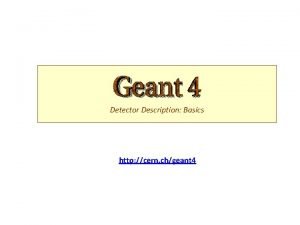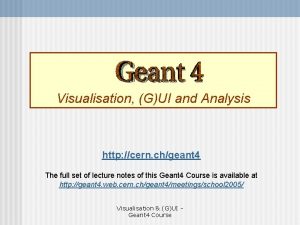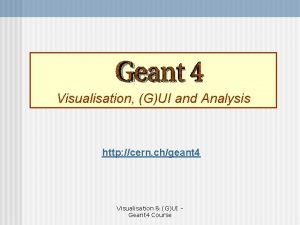Electromagnetic Physics http cern chgeant 4 The full
































![Rayleigh scattering Angular distribution: F(E, q)=[1+cos 2(q)] F 2(q) – where F(q) is the Rayleigh scattering Angular distribution: F(E, q)=[1+cos 2(q)] F 2(q) – where F(q) is the](https://slidetodoc.com/presentation_image_h/005699b310497bc89c40805f39b98d52/image-33.jpg)






























- Slides: 63

Electromagnetic Physics http: //cern. ch/geant 4 The full set of lecture notes of this Geant 4 Course is available at http: //www. ge. infn. it/geant 4/events/nss 2003/geant 4 course. html Geant 4 Training 2003

Standard Electromagnetic Physics Michel Maire LAPP Geant 4 Training 2003

Standard electromagnetic physics in Geant 4 The model assumptions are: The projectile has energy 1 ke. V Atomic electrons are quasi free: their binding energy is neglected (except for the photoelectric effect) The atomic nucleus is free: the recoil momentum is neglected Matter is described as homogeneous, isotropic, amorphous Geant 4 Training 2003

Compton scattering Geant 4 Training 2003

Standard Compton scattering in Geant 4 Training 2003

g conversion Geant 4 Training 2003

Standard total cross section per atom in Geant 4 Training 2003

Ionisation Geant 4 Training 2003

Mean rate of energy loss Geant 4 Training 2003

Fluctuations in energy loss The model in Geant 4 Training 2003

Production of d rays 2000 Me. V electron, proton and a in Al Geant 4 Training 2003

Bremsstrahlung Differential cross section Geant 4 Training 2003

Emission of energetic photons and truncated energy loss rate 1 Me. V cut 10 ke. V cut Geant 4 Training 2003

LPM effect LPM 10 Ge. V e in Pb, g spectrum Geant 4 Training 2003

Multiple Coulomb scattering Geant 4 Training 2003

Particle transport in Monte Carlo simulation Geant 4 Training 2003

Multiple scattering in Geant 4 More details in Geant 4 Physics Reference Manual Geant 4 Training 2003

Cherenkov radiation Cherenkov emission from optical photons in Geant 4 Training 2003

Optical photons Production of optical photons in detectors is mainly due to Cherenkov effect and scintillation Processes in Geant 4: in flight absorption Rayleigh scattering medium boundary interactions (reflection, refraction) Geant 4 Training 2003 Photon entering a light concentrator CTF-Borexino

Muons 1 ke. V up to 1000 Pe. V scale simulation of ultra-high energy and cosmic ray physics High energy extensions based on theoretical models 45 Ge. V muons Geant 4 Training 2003

Direct e+e- pair creation by muon Geant 4 Training 2003

Photo Absorption Ionisation (PAI) Model Ionisation energy loss produced by charged particles in thin layers of absorbers 3 Ge. V/c p in 1. 5 cm Ar+CH 4 5 Ge. V/c p in 20. 5 mm Si Ionisation energy loss distribution produced by pions, PAI model Geant 4 Training 2003

Low Energy Electromagnetic Physics Maria Grazia Pia INFN Genova Maria. Grazia. Pia@cern. ch on behalf of the Low Energy Electromagnetic Working Group http: //www. ge. infn. it/geant 4/low. E/ Geant 4 Training 2003

What is A package in the Geant 4 electromagnetic package – geant 4/source/processes/electromagnetic/lowenergy/ A set of processes extending the coverage of electromagnetic interactions in Geant 4 down to “low” energy – 250 e. V (in principle even below this limit)/100 ev for electrons and photons – down to the approximately the ionisation potential of the interacting material for hadrons and ions A set of processes based on detailed models – shell structure of the atom – precise angular distributions Complementary to the “standard” electromagnetic package Geant 4 Training 2003

Overview of physics Compton scattering Rayleigh scattering Photoelectric effect Pair production In progress – More precise angular distributions (Rayleigh, photoelectric, Bremsstrahlung etc. ) – Polarised g conversion, photoelectric Bremsstrahlung Ionisation in two “flavours” of models: Polarised Compton • based on the Livermore Library • à la Penelope + atomic relaxation – fluorescence – Auger effect following processes leaving a vacancy in an atom Development plan – Driven by user requirements – Schedule compatible with available resources Geant 4 Training 2003

Software Process A rigorous approach to software engineering in support of a better quality of the software especially relevant in the physics domain of Geant 4 -Low. E EM several mission-critical applications (space, medical…) Spiral approach A life cycle model that is both iterative and incremental Collaboration wide Geant 4 software process, tailored to the specific projects Public URD Huge effort invested into SPI l l started from level 1 (CMM) in very early stages: chaotic, left to heroic improvisation current status Geant 4 Training 2003 Full traceability through UR/OOD/implementation/test Testing suite and testing process Public documentation of procedures Defect analysis and prevention etc. …

User requirements Various methodologies adopted to capture URs Elicitation through interviews and surveys l User Requirements useful to ensure that UR are complete and there is wide agreement Joint workshops with user groups Use cases Analysis of existing Monte Carlo codes Study of past and current experiments Direct requests from users to WG coordinators Geant 4 Training 2003 WG e h t d on e t s o P site web

Low. E processes based on Livermore Library Geant 4 Training 2003

Photons and electrons Based on evaluated data libraries from LLNL: different approach w. r. t. Geant 4 standard e. m. package – EADL (Evaluated Atomic Data Library) – EEDL (Evaluated Electrons Data Library) – EPDL 97 (Evaluated Photons Data Library) especially formatted for Geant 4 distribution (courtesy of D. Cullen, LLNL) Validity range: 250 e. V 100 Ge. V – The processes can be used down to 100 e. V, with degraded accuracy – In principle the validity range of the data libraries extends down to ~10 e. V Elements Z=1 to Z=100 – Atomic relaxation: Z > 5 (transition data available in EADL) Geant 4 Training 2003

Calculation of cross sections Interpolation from the data libraries: E 1 and E 2 are the lower and higher energy for which data (s 1 and s 2) are available Mean free path for a process, at energy E: ni = atomic density of the ith element contributing to the material composition Geant 4 Training 2003

Photons Geant 4 Training 2003

Compton scattering Klein Nishina cross section: Energy distribution of the scattered photon according to the Klein Nishina formula, multiplied by scattering functions F(q) from EPDL 97 data library The effect of scattering function becomes significant at low energies – suppresses forward scattering Angular distribution of the scattered photon and the recoil electron also based on EPDL 97 Geant 4 Training 2003
![Rayleigh scattering Angular distribution FE q1cos 2q F 2q where Fq is the Rayleigh scattering Angular distribution: F(E, q)=[1+cos 2(q)] F 2(q) – where F(q) is the](https://slidetodoc.com/presentation_image_h/005699b310497bc89c40805f39b98d52/image-33.jpg)
Rayleigh scattering Angular distribution: F(E, q)=[1+cos 2(q)] F 2(q) – where F(q) is the energy dependent form factor obtained from EPDL 97 Improved angular distribution released in 2002, further improvements foreseen Geant 4 Training 2003

Photoelectric effect Cross section – Integrated cross section (over the shells) from EPDL + interpolation – Shell from which the electron is emitted selected according to the detailed cross sections of the EPDL library Final state generation – Direction of emitted electron = direction of incident photon Deexcitation via the atomic relaxation sub process – Initial vacancy + following chain of vacancies created Geant 4 Training 2003

g conversion The secondary e and e+ energies are sampled using Bethe Heitler cross sections with Coulomb correction e and e+ assumed to have symmetric angular distribution Energy and polar angle sampled w. r. t. the incoming photon using Tsai differential cross section Azimuthal angle generated isotropically Choice of which particle in the pair is e or e+ is made randomly Geant 4 Training 2003

Photons: mass attenuation coefficient Comparison against NIST data NIST XCOM G 4 Standard Low. E Fe Tests by IST Natl. Inst. for Cancer Research, Genova (F. Foppiano et al. ) G 4 Low. E standard 2 N L=13. 1 – =20 p=0. 87 2 N S=23. 2 – =15 p=0. 08 Low. E accuracy ~ 1% Geant 4 Training 2003

Photons, evidence of shell effects Photon transmission, 1 mm Pb Photon transmission, 1 mm Al Geant 4 Training 2003

Polarisation Cross section: x Scattered Photon Polarization 250 e. V 100 Ge. V x h 0 O h a A z C y 100 ke. V small large Polar angle Azimuthal angle Polarization vector 1 Me. V small More details: talk on large Low Energy Polarised Compton 10 Me. V small Geant 4 Low Energy Electromagnetic Physics large Geant 4 Training 2003 Other polarised processes under development

Polarisation theory 500 million events simulation Polarisation of a non polarised photon beam, simulation and theory Ratio between intensity with perpendicular and parallel polarisation vector w. r. t. scattering plane, linearly polarised photons Geant 4 Training 2003

Electron Bremsstrahlung Parameterisation of EEDL data – 16 parameters for each atom – At high energy the parameterisation reproduces the Bethe Heitler formula – Precision is ~ 1. 5 % Plans – Systematic verification over Z and energy Geant 4 Training 2003

Electron ionisation Parameterisation based on 5 parameters for each shell Precision of parametrisation is better then 5% for 50 % of shells, less accurate for the remaining shells Work in progress to improve the parameterisation and the performance Geant 4 Training 2003

Electron ionisation New parameterisations of EEDL data library recently released – precision is now better than 5 % for ~ 50% of the shells, poorer for the 50% left Plans – Systematic verification over shell, Z and energy – New Test & Analysis Project for automated verification (all shells, 99 elements!) Geant 4 Training 2003

Electrons: range Range in various simple and composite materials Al Compared to NIST database NIST ESTAR G 4 Standard G 4 Low. E Geant 4 Training 2003

Electrons: d. E/dx Ionisation energy loss in various materials Compared to Sandia database More systematic verification planned Also Fe, Ur Geant 4 Training 2003

Electrons, transmitted 20 ke. V electrons, 0. 32 and 1. 04 mm Al Geant 4 Training 2003

The problem of validation: finding reliable data Note: Geant 4 validation is not always easy Backscattering low energies - Au Geant 4 Training 2003 experimental data often exhibit large differences!

Hadrons and ions Variety of models, depending on – energy range – particle type – charge Composition of models across the energy range, with different approaches – analytical – based on data reviews + parameterisations Specialised models for fluctuations Open to extension and evolution Geant 4 Training 2003

Hadrons and ions Physics models handled through abstract classes Algorithms encapsulated in objects Transparency of physics, clearly exposed to users Interchangeable and transparent access to. Geant 4 data Training sets 2003

Positive charged hadrons Bethe-Bloch model of energy loss, E > 2 Me. V 5 parameterisation models, E < 2 Me. V based on Ziegler and ICRU reviews 3 models of energy loss fluctuations Ziegler and ICRU, Fe Ziegler and ICRU, Si Density correction for high energy Shell correction term for intermediate Spin dependent term Spin energy Barkas and Bloch terms Chemical effect for Chemical compounds Nuclear stopping power PIXE included (preliminary) Straggling Stopping power Z dependence for various energies Geant 4 Training 2003 Nuclear stopping power

The precision of the stopping power simulation for protons in the energy from 1 ke. V to 10 Ge. V is of the order of a few per cent Bragg peak (with hadronic interactions) Geant 4 Training 2003

Positive charged ions Scaling: 0. 01 < < 0. 05 parameterisations, Bragg peak based on Ziegler and ICRU reviews < 0. 01: Free Electron Gas Model Effective charge model Nuclear stopping power Deuterons Geant 4 Training 2003

Models for antiprotons > 0. 5 0. 01 < < 0. 5 < 0. 01 Bethe Bloch formula Quantum harmonic oscillator model Free electron gas mode Proton G 4 Antiproton Antiproto n exp. data Antiproton from Arista et. al Geant 4 Training 2003

Atomic relaxation Geant 4 Training 2003

Fluorescence Microscopic validation: against reference data Experimental validation: test beam data, in collaboration with ESA Advanced Concepts & Science Payload Division Spectrum from a Mars-simulant rock sample Fe lines Ga. As lines Scattered photons Geant 4 Training 2003

Auger effect New implementation, validation in progress Auger electron emission from various materials Sn, 3 ke. V photon beam, electron lines w. r. t. published experimental results Geant 4 Training 2003

Processes à la Penelope The whole physics content of the Penelope Monte Carlo code has been re engineered into Geant 4 (except for multiple scattering) – processes for photons: release 5. 2, for electrons: release 6. 0 Physics models by F. Salvat et al. Power of the OO technology: – extending the software system is easy – all processes obey to the same abstract interfaces – using new implementations in application code is simple Profit of Geant 4 advanced geometry modeling, interactive facilities etc. – same physics as original Penelope Geant 4 Training 2003

Contribution from users Many valuable contributions to the validation of Low. E physics from users all over the world – excellent relationship with our user community User comparisons with data usually involve the effect of several physics processes of the Low. E package A small sample in the next slides – no time to show all! Geant 4 Training 2003

Homogeneous Phantom P. Rodrigues, A. Trindade, L. Peralta, J. Varela, LIP § § § Simulation of photon beams produced by a Siemens Mevatron KD 2 clinical linear accelerator Phase space distributions interface with GEANT 4 Validation against experimental data: depth dose and profile curves ! Differences LIP – Lisbon 10 x 10 cm 2 15 x 15 cm 2 Geant 4 Training 2003 ry a n mi P i l e r 10 x 10 15 x 15 cm 2

Dose Calculations with 12 C P. Rodrigues, A. Trindade, L. Peralta, J. Varela, LIP Bragg peak localization calculated with GEANT 4 (stopping powers from ICRU 49 and Ziegler 85) and GEANT 3 in a water phantom Comparison with GSI data ry a n i im rel p Geant 4 Training 2003 i l e Pr m ! y r ina

Uranium irradiated by electron beam Jean Francois Carrier, Louis Archambault, Rene Roy and Luc Beaulieu Service de radio oncologie, Hotel Dieu de Quebec, Canada Departement de physique, Universite Laval, Quebec, Canada re a y The dical. n soo for me d e lish roject b u be p ation p ! l l y i r d w i l a s in sult ant 4 va tions. e r m a i g e l win ral G applic re o l l P e o f n The of a ge t par Fig 1. Depth dose curve for a semi infinite uranium slab irradiated by a 0. 5 Me. V broad parallel electron beam Geant 4 Training 2003 1 Chibani O and Li X A, Med. Phys. 29 (5), May 2002

Ions Independent validation at Univ. of Linz (H. Paul et al. ) Geant 4 Low. E reproduces the right side of the distribution precisely, but about 10 20% discrepancy is observed at lower energies Geant 4 Training 2003 y! r a n i Prelim

To learn more Geant 4 Physics Reference Manual Application Developer Guide http: //www. ge. infn. it/geant 4/low. E Geant 4 Training 2003

Summary OO technology provides the mechanism for a rich set of electromagnetic physics models in Geant 4 – further extensions and refinements are possible, without affecting Geant 4 kernel or user code Two main approaches in Geant 4: – standard – Low Energy (Livermore Library / Penelope) each one offering a variety of models for specialised applications Extensive validation activity and results More on Physics Reference Manual and web site Geant 4 Training 2003
 Cern particle physics
Cern particle physics Cern particle physics
Cern particle physics Http //mbs.meb.gov.tr/ http //www.alantercihleri.com
Http //mbs.meb.gov.tr/ http //www.alantercihleri.com Siat ung sistem informasi akademik
Siat ung sistem informasi akademik Kcvs.ca
Kcvs.ca Http://www.colorado.edu/physics/phet
Http://www.colorado.edu/physics/phet Why does it happen
Why does it happen University physics with modern physics fifteenth edition
University physics with modern physics fifteenth edition Easy physics ia ideas
Easy physics ia ideas Hát kết hợp bộ gõ cơ thể
Hát kết hợp bộ gõ cơ thể Ng-html
Ng-html Bổ thể
Bổ thể Tỉ lệ cơ thể trẻ em
Tỉ lệ cơ thể trẻ em Voi kéo gỗ như thế nào
Voi kéo gỗ như thế nào Chụp tư thế worms-breton
Chụp tư thế worms-breton Bài hát chúa yêu trần thế alleluia
Bài hát chúa yêu trần thế alleluia Các môn thể thao bắt đầu bằng tiếng bóng
Các môn thể thao bắt đầu bằng tiếng bóng Thế nào là hệ số cao nhất
Thế nào là hệ số cao nhất Các châu lục và đại dương trên thế giới
Các châu lục và đại dương trên thế giới Công thức tính độ biến thiên đông lượng
Công thức tính độ biến thiên đông lượng Trời xanh đây là của chúng ta thể thơ
Trời xanh đây là của chúng ta thể thơ Cách giải mật thư tọa độ
Cách giải mật thư tọa độ Làm thế nào để 102-1=99
Làm thế nào để 102-1=99 Phản ứng thế ankan
Phản ứng thế ankan Các châu lục và đại dương trên thế giới
Các châu lục và đại dương trên thế giới Thơ thất ngôn tứ tuyệt đường luật
Thơ thất ngôn tứ tuyệt đường luật Quá trình desamine hóa có thể tạo ra
Quá trình desamine hóa có thể tạo ra Một số thể thơ truyền thống
Một số thể thơ truyền thống Bàn tay mà dây bẩn
Bàn tay mà dây bẩn Vẽ hình chiếu vuông góc của vật thể sau
Vẽ hình chiếu vuông góc của vật thể sau Nguyên nhân của sự mỏi cơ sinh 8
Nguyên nhân của sự mỏi cơ sinh 8 đặc điểm cơ thể của người tối cổ
đặc điểm cơ thể của người tối cổ Thứ tự các dấu thăng giáng ở hóa biểu
Thứ tự các dấu thăng giáng ở hóa biểu Vẽ hình chiếu đứng bằng cạnh của vật thể
Vẽ hình chiếu đứng bằng cạnh của vật thể Phối cảnh
Phối cảnh Thẻ vin
Thẻ vin đại từ thay thế
đại từ thay thế điện thế nghỉ
điện thế nghỉ Tư thế ngồi viết
Tư thế ngồi viết Diễn thế sinh thái là
Diễn thế sinh thái là Dot
Dot Số nguyên là gì
Số nguyên là gì Tư thế ngồi viết
Tư thế ngồi viết Lời thề hippocrates
Lời thề hippocrates Thiếu nhi thế giới liên hoan
Thiếu nhi thế giới liên hoan ưu thế lai là gì
ưu thế lai là gì Khi nào hổ con có thể sống độc lập
Khi nào hổ con có thể sống độc lập Sự nuôi và dạy con của hổ
Sự nuôi và dạy con của hổ Sơ đồ cơ thể người
Sơ đồ cơ thể người Từ ngữ thể hiện lòng nhân hậu
Từ ngữ thể hiện lòng nhân hậu Thế nào là mạng điện lắp đặt kiểu nổi
Thế nào là mạng điện lắp đặt kiểu nổi Electromagnetic waves vocabulary
Electromagnetic waves vocabulary Transverse waves move perpendicular
Transverse waves move perpendicular Sound waves are transverse waves true or false
Sound waves are transverse waves true or false Mechanical and electromagnetic waves
Mechanical and electromagnetic waves Electromagnetic waves def
Electromagnetic waves def Mechanical and electromagnetic waves similarities
Mechanical and electromagnetic waves similarities Energy density in electromagnetic wave
Energy density in electromagnetic wave Longest wavelength in electromagnetic spectrum
Longest wavelength in electromagnetic spectrum Electromagnetic star
Electromagnetic star Em spectrum song lyrics
Em spectrum song lyrics Wavelength of electromagnetic radiation formula
Wavelength of electromagnetic radiation formula Difference between matter waves and electromagnetic waves
Difference between matter waves and electromagnetic waves Electromagnetic particle inspection
Electromagnetic particle inspection
